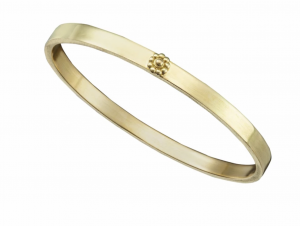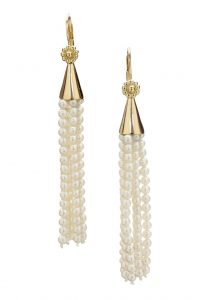Ethics and Art: Christina Malle Advocates for Beauty, Without Compromising Humanity
Christina Malle has a mission to bring human rights to the designer jewelry industry. Drawing from her experience as a human rights attorney, she advocates for ethical sourcing and responsible jewelry practices. Alongside advocating for jewelry ethics, she draws from an array of inspirations for her jewelry. From 14th Century European art to modern photography, Malle brings to life the symbolism of fine art for her clients to celebrate the real drama of our everyday lives.

Yellow Gold Coil Ring by Christina Malle
Christina, anyone that reads the “About” page on your website will get the message that you care about the process that the gemstone or metal goes through before you fashion them. What sparked your passion to ensure that these are obtained responsibly and with care?
Before I started making jewelry professionally, I was a human rights attorney. One of my clients had panned for gold in Sierra Leone, in an attempt to eke out a living. Other clients were from countries rich in natural resources such as diamonds and gold; yet, most citizens from those resource-rich countries remain crushingly poor. It made me wonder where gemstones and metals were from, how they were mined, and who benefitted from their trade.
You are part of the Ethical Metalsmiths group. Could you explain to us what the purpose of this group is?
The mission of Ethical Metalsmiths is to “inspire responsible jewelry practices through education, connection and action.” EM does this on its website, through an email forum where members share resources and information; and through seminars, conferences and other events. It is an incredible network of energetic and conscientious makers, students, and industry professionals. We want to minimize the environmental impact of the jewelry supply chain, and ensure a transparent and traceable supply chain. I would encourage everyone to visit the website and consider joining. I am a member of EM, and I also serve on its board of directors. EM is a 501(c)(3) nonprofit organization, and our work is for the public interest. It has been an incredible vehicle for meeting leaders in the jewelry industry, and beyond.

Yellow Gold Rosette Thick Bangle Bracelet by Christine Malle
For example, Ethical Metalsmiths supported the third annual Chicago Responsible Jewelry Conference. Presenters ranged from Pure Earth (an NGO fighting pollution), the United States Department of State, Google, two chiefs from very deep in the Amazon in Brazil, and to women miners from Tanzania. We also heard from jewelry designers, gemstone dealers, gold miners, Human Rights Watch, environmental activists…. and so on! It was a remarkable assortment of people all gathered in one room, working to improve transparency and conditions along the jewelry supply chain. I would not have known about the conference, let alone have attended, if not for Ethical Metalsmiths.
The Ethical Metalsmiths website can be viewed at ethicalmetalsmiths.org.
What motivated you to move on from being a human rights attorney to being a jewelry designer? Do you believe that being an advocate for human rights played a part in you being an advocate for responsible gemstone and metal mining?
My local Y, which is called the 92nd Street Y on the upper east side of Manhattan, advertised a class called “Goldsmithing for Absolute Beginners.” I had always loved jewelry but had never thought I could actually make anything. I was an attorney, and apart from cooking, I had never made anything in my life! The title of the class spoke to me, and I simply had to sign up. By sheer serendipity, Donna Distefano was the instructor. Donna is a master goldsmith, who has an exceptional company based on 22 karat jewelry made in her atelier. She became my teacher, and I would like to thank her for everything she has taught me! Her work is pure art! When I started goldsmithing, I was still representing asylum seekers. We had exceptional clients who had powerfully strong cases for asylum, which also meant there was a great deal of devastation and heartbreak involved. Goldsmithing was a balm. If I made a mistake, I could melt the gold and start again. With an asylum-seeker, an unhappy outcome could mean returning to the country of origin, which in turn could mean imprisonment or worse.
What has been a memorable moment in your jewelry design career that you will always cherish?

Pearl and Yellow Gold Tassel Earrings by Christina Malle
This makes my day: a client sees a woman wearing a piece, such as my South Sea Pearl necklace or my Rosette earrings, and says “I like your earrings, are they Christina Malle?” This has happened several times, and really puts a spring in my step!
Or recently, a client commissioned a pendant for her mother for her birthday. I started to explain the rosette detail, which I first saw in a 15th century Fra Angelico painting in Tuscany. The client told me her mother was obsessed with Fra Angelico, and had a photo of the very same painting in her home. I just knew we were on the same page aesthetically! I am delighted to say that my client reported back that her mother wears the pendant every day. This was music to a goldsmith’s ears!
Do you have a favorite piece of jewelry in the collections you have made in the past?
Nope! I love all of my pieces and intend them to be timeless. I am happy to say that my clients really wear their pieces over time, either on their own, or layered with other pieces. That also makes my day!
What are your goals for Christina Malle Jewelry and the Ethical Metalsmiths group?
It is heartening to see the human rights world and jewelry world coming together. I look forward to a fully transparent and traceable jewelry supply chain – for jewelers and consumers to use. And I look forward to meeting more people who admire beautiful jewelry!
What efforts are made now, to keep and grow the transparency of the jewelry industry supply chain?
This sounds simplistic, but if all shoppers ask these questions, it will go a long way in creating a transparent and traceable jewelry supply chain: “Where is it from,” “How was it made,” and “How do we know?” Whether you buy from me, from another independent designer, or from a chain store, please ask! The same goes for gemstones. It is unacceptable, but true, that it can be very hard – even for jewelers – to trace our own supply chains. I became Fairmined certified in 2019, after hearing from miners themselves at the Chicago Responsible Jewelry conference. Fairmined allows me to track gold from the mine to me. Craft gold is a similar idea, where one can track the gold to the point of origin. Colored gemstones are quite challenging to trace, but stay tuned! Between regulatory pressures from the EU, to companies that want to do the right thing, to consumers demanding answers, the pressure is on to be held accountable. That is good for everyone and for planet earth.